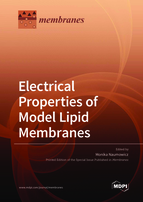Electrical Properties of Model Lipid Membranes
A special issue of Membranes (ISSN 2077-0375). This special issue belongs to the section "Biological Membrane Composition and Structures".
Deadline for manuscript submissions: closed (20 February 2022) | Viewed by 24910
Special Issue Editor
Interests: lipid membranes; liposomes; emerging pollutant; toxicology
Special Issues, Collections and Topics in MDPI journals
Special Issue Information
Dear Colleagues,
Biological membranes are crucial elements of the living systems, and processes occurring with their participation are related mainly to electric phenomena such as transfer of signals, existence of membrane potentials, and transport through the membrane. It has been evident that the lipid bilayer which forms the environment for integral and surface membrane proteins is commonly known as the universal model of the cell-membrane structure. Thus, a great deal of attention has shifted towards the investigation of the organization and properties of these structures concerning both experimental and theoretical aspects. Because systematic examinations are impeded by the complexity of the natural membranes, the best approach to perform detailed physical and chemical studies of biological membranes is to use simplified well-defined model lipid membranes. These models can be exploited to acquire information on the properties of actual biological membranes and associated electrochemical reactions. The most frequently used ones are liposomes, black lipid membranes, membranes on solid substrates, and lipid monolayers on the free surface.
Investigation of the electrochemical properties of model lipid membranes has been carried out over a number of years. However, there is a broad spectrum of issues that have not been subjected to experimental verification and for which the existing results are incomplete or inconsistent. Therefore, the main focus of this forthcoming Special Issue is to present a comprehensive overview of the field by assembling state-of-the-art research articles and reviews on electrical properties of model lipid membranes.
Dr. Monika Naumowicz
Guest Editor
Manuscript Submission Information
Manuscripts should be submitted online at www.mdpi.com by registering and logging in to this website. Once you are registered, click here to go to the submission form. Manuscripts can be submitted until the deadline. All submissions that pass pre-check are peer-reviewed. Accepted papers will be published continuously in the journal (as soon as accepted) and will be listed together on the special issue website. Research articles, review articles as well as short communications are invited. For planned papers, a title and short abstract (about 100 words) can be sent to the Editorial Office for announcement on this website.
Submitted manuscripts should not have been published previously, nor be under consideration for publication elsewhere (except conference proceedings papers). All manuscripts are thoroughly refereed through a single-blind peer-review process. A guide for authors and other relevant information for submission of manuscripts is available on the Instructions for Authors page. Membranes is an international peer-reviewed open access monthly journal published by MDPI.
Please visit the Instructions for Authors page before submitting a manuscript. The Article Processing Charge (APC) for publication in this open access journal is 2700 CHF (Swiss Francs). Submitted papers should be well formatted and use good English. Authors may use MDPI's English editing service prior to publication or during author revisions.
Keywords
- Model lipid membranes
- Black lipid bilayers
- Liposomes
- Biomedical sciences
- Bioinspired materials
- Physicochemical phenomena at the membrane surface
- Electrical properties of model membranes
- Electroanalytical methods







